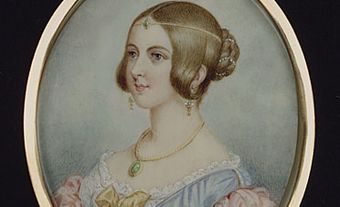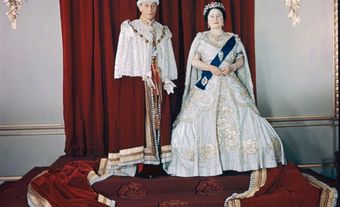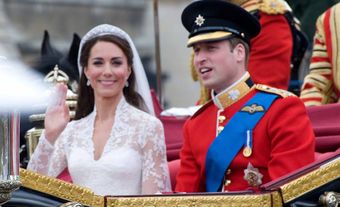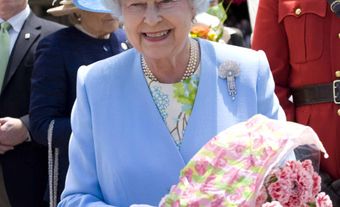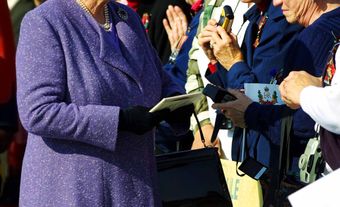Elizabeth the Second, Queen of Canada, the United Kingdom and 13 other Commonwealth realms (born 21 April 1926 in London, United Kingdom; died 8 September 2022 at Balmoral Castle, Aberdeenshire, Scotland). The Queen reigned since 1952 and was the Head of State of Canada, the United Kingdom and 13 other Commonwealth realms. Elizabeth II was the first monarch to be crowned Queen of Canada. She was the longest reigning monarch in British and Commonwealth history and celebrated her Platinum Jubilee, the 70th anniversary of her accession to the throne, in 2022.
Birth
Princess Elizabeth Alexandra Mary was born on 21 April 1926 at 17 Bruton Street, the London home of her maternal grandparents, Claude and Cecilia Bowes-Lyon, the Earl and Countess of Strathmore. Her parents were Prince Albert, Duke of York (the future George VI), second son of the reigning King George V and Queen Mary, and the Duchess of York, the former Lady Elizabeth Bowes-Lyon.
At the time of her birth, she was third in line to the throne, but it seemed unlikely that she would ever become Queen. Her uncle, the future Edward VIII, was unmarried at the time but the public assumed that he would eventually marry and have children of his own. The succession laws of the period dictated that any sons born to the Duke and Duchess of York would precede Elizabeth in the line of succession. Nevertheless, there was public interest in the birth of King George V`s first granddaughter. Elizabeth was christened in the private chapel at Buckingham Palace on 29 May 1926. Her godparents included a former Governor General of Canada, her great-grand-uncle Prince Arthur, Duke of Connaught.
Early Life
When Elizabeth was only eight months old her parents embarked on a six-month world tour, visiting Australia and New Zealand. Although the Duchess of York wrote in her diary that she was "very miserable at leaving the baby," the young Elizabeth remained in the United Kingdom in the care of her grandparents as was customary for royal tours at the time. Despite these periodic absences for royal duties, Elizabeth, her parents, and her younger sister, Princess Margaret Rose (1930–2002), were a close family who enjoyed spending time together. Although George V had a reputation for severity toward his children, he doted on his granddaughter, and she enjoyed a close relationship with all her grandparents.
Abdication Crisis
On 20 January 1936, George V died and Elizabeth’s uncle succeeded to throne as King Edward VIII. He reigned for only 11 months before abdicating on 10 December to marry a twice-divorced American, Wallis Simpson. The abdication changed 10-year-old Elizabeth’s life. With the accession of her father as King George VI, she became the heiress presumptive, and the family moved into Buckingham Palace. The young princesses were not happy with the changes that their father’s ascension brought to their lives, which included less privacy and less time with their parents.
Education
Elizabeth and Margaret were educated at home by a governess, Marion Crawford, who taught history, geography, grammar, literature, and composition. They also had additional governesses who taught French, music and dancing. The Queen was fluently bilingual in French and English. Elizabeth’s grandmother, Queen Mary, took a strong interest in the education of her granddaughters and took them to museums and historic sites to increase their knowledge of the history and politics of the British Isles. As she grew older, Elizabeth received additional training to prepare her for her future position, including history and political science lessons with the vice provost of Eton College, Sir Henry Marten, and extensive time spent with her father, learning the duties of a constitutional monarch first-hand.
Second World War
Elizabeth and Margaret resided at Windsor Castle, outside London, throughout the Second World War. During this time, Elizabeth continued her education and began to assume official duties. At the age of 14, she made her first radio broadcast, addressing the children of the United Kingdom and Commonwealth as part of the BBC Children’s Hour. Elizabeth carried out her first solo engagement in 1942, inspecting the Grenadier Guards in her capacity as Honorary Colonel-in-Chief on her 16th birthday. She began accompanying her parents on royal engagements throughout the United Kingdom in 1944 and became a Counsellor of State. In 1945, Elizabeth joined the Auxiliary Territorial Service as a subaltern and rose to the rank of junior commander by the end of the war.
Marriage
Elizabeth met Prince Philip of Greece and Denmark in childhood and first became interested in him when he gave her a tour of the Dartmouth Naval College in 1939. They corresponded throughout the Second World War and Philip spent periods of leave from the Royal Navy at Windsor Castle.
On 9 July 1947, Buckingham Palace announced the engagement of Elizabeth and Philip. In Canada, Prime Minister William Lyon Mackenzie King summoned the King’s Canadian Privy Council to approve the union of the future Queen of Canada. Elizabeth and Philip were married at Westminster Abbey in London on 20 November 1947. The ceremony was broadcast over BBC radio to an audience of 200 million people around the world, allowing Canada to share in the celebrations. Mackenzie King sent the royal couple antique silver as a wedding gift (in consultation with a former viceregal consort, the Countess of Athlone, a granddaughter of Queen Victoria), as well as a mink coat for the Princess.
Motherhood
The royal couple’s first child, Prince Charles, was born at Buckingham Palace on 14 November 1948. A daughter, Princess Anne, was born on 15 August 1950, followed 10 years later by Prince Andrew (19 February 1960) and later Prince Edward (10 March 1964). Elizabeth expressed her intention to be a hands-on mother and nursed Charles until she caught the measles when he was two months old. George VI’s declining health, however, meant that Elizabeth assumed a demanding schedule of royal engagements while her children were young. As Queen, her extensive Commonwealth tours resulted in her children spending long periods with nannies and with their grandmother, Queen Elizabeth, the Queen Mother.
First Tour of Canada
Elizabeth visited Canada for the first time in the autumn of 1951, accompanied by Philip. The royal couple were representing George VI, who had just undergone surgery for lung cancer. There was tremendous popular interest in the tour because Elizabeth and Philip, like William and Catherine in 2011, appeared to be a glamorous young royal couple who would modernize the monarchy. They were the first royal couple to visit Canada via transatlantic aircraft rather than ship and they threw themselves into Canadian pastimes, attending a hockey game at Maple Leaf Gardens and a demonstration of the Calgary Stampede, and square dancing at Rideau Hall. They were well-received by Canadians from all walks of life though Elizabeth appeared to be quieter and more reserved than the gregarious Philip. After her return to the United Kingdom, Elizabeth reflected on her time in Canada: "I am sure that nowhere under the sun could one find a land more full of hope, of happiness and of fine, loyal, generous-hearted people. […] They have placed in our hearts a love for their country and its people which will never grow cold and which will always draw us to their shores."
Accession to the Throne
George VI died on 6 February 1952 while Elizabeth and Philip were representing him on a trip to Kenya. The 25-year-old Princess automatically succeeded to throne as Queen Elizabeth II. The new Queen and her husband immediately returned to the United Kingdom and ascended to the throne in a climate of tremendous public goodwill. Both her father and grandfather had been second sons who were not raised to be King, but Elizabeth had been heiress presumptive from a young age and was extremely popular.
Canada was between Governors General at the time so the Chief Justice, Thibaudeau Rinfret, proclaimed “The High and Mighty Princess Elizabeth Alexandra Mary” Queen and “Supreme Liege Lady in and over Canada.” In December 1952, the new Queen’s formal Canadian titles were decided at the Commonwealth Prime Ministers’ Conference in London: Elizabeth the Second, by the Grace of God of the United Kingdom, Canada and Her other Realms and Territories Queen, Head of the Commonwealth, Defender of the Faith.
Coronation
Elizabeth II was crowned Queen at Westminster Abbey on 2 June 1953 and made history by becoming the first monarch to be crowned Head of the Commonwealth and Queen of Canada. Her dress included symbols from the Commonwealth realms, with embroidered maple leaves representing Canada (see also Emblems of Canada).
The Queen’s unprecedented decision to permit television cameras to film the coronation allowed the entire Commonwealth to share in the celebrations. The coronation became the first transatlantic television broadcast as the footage was flown to Canada to be shown on the CBC. Prime Minister Louis St-Laurent attended the coronation in London while Governor General Vincent Massey presided over the celebrations on Parliament Hill, which were attended by 100,000 people. There were additional celebrations across Canada. St. John’s, Newfoundland, held the largest parade in the city’s history and there was a coronation show at the Canadian National Exhibition in Toronto.
Political Role in Canada
Canada is a constitutional monarchy with a King or Queen as Head of State. The Crown holds the power to govern but this power is entrusted to the government, which is expected to lead on behalf of the people. The Crown serves as a level of government that is above party politics and holds reserve powers such as appointing the Prime Minister, opening Parliament, proroguing Parliament and calling an election. Bills passed by the House of Commons and Senate must receive Royal Assent to become law. In Canada, the Crown is represented by the Governor General at the federal level and Lieutenant-Governors at the provincial level. During her time in Canada, however, the Queen directly exercised her prerogatives as Head of State. In 1957, on her first visit to Canada after her accession, the Queen opened Parliament and delivered the throne speech in person. In 1976, the Queen declared the Olympic Summer Games in Montréal open in her capacity as Canada’s Head of State. In 1977, during her Silver Jubilee tour of Canada, the Queen delivered the Speech from the Throne and opened the third session of the 30th Parliament. In 1982, the Queen signed the Proclamation of the Constitution Act with Prime Minister Pierre Trudeau. The Queen made 22 official visits to Canada, more than any other Commonwealth realm outside the United Kingdom.
Head of the Commonwealth
From the beginning of her reign, the Queen devoted herself to the role of Head of the Commonwealth. She was the most well-travelled monarch in history and visited all Commonwealth nations except Cameroon and Rwanda. The issue of South African apartheid dominated early Commonwealth Heads of Government meetings and allowed the Queen to exert political influence in her role as Head of the Commonwealth. During the 1980s, Canadian Prime Minister Brian Mulroney supported economic sanctions against the apartheid regime, measures which British Prime Minister Margaret Thatcher opposed. The Queen supported Mulroney’s stance as well as the release of future South African President Nelson Mandela from prison.
The Quiet Revolution in Quebec
Until the 1960s, the monarchy was popular in Québec because the Crown was viewed as a protector of minority rights. When the Queen’s parents visited Montréal in 1939, they estimated that two million people had greeted them in the city. In 1953, celebrations were held in Québec City in honour of the Queen’s coronation. However, the Quiet Revolution of the 1960s changed attitudes toward the monarchy, presenting the Queen as a symbol of British oppression. In 1964, the Queen addressed the Québec legislative assembly in French, stating, “I am pleased to think that there exists in our Commonwealth a country where I can express myself officially in French.” Despite these sentiments, the Queen faced crowds of protesters who turned their backs on her and chanted, “Elizabeth, go home.” The police crackdown on these protests became known as “Truncheon Sunday.” In 1977, the Queen delivered a televised address to Canadians stating, “The confederation itself was not a French idea or a British idea,” which The New York Times interpreted as supporting Prime Minister Pierre Trudeau’s efforts to keep Canada united in response to Quebec separatism.
The Monarchy in English Canada
In English Canada, the monarchy inspired growing indifference rather than hostility during the same period. In 1959, CBC journalist Joyce Davidson commented on NBC’s Today show, “Like most Canadians, I am indifferent to the visit of the Queen,” referring to the Queen and Prince Philip’s six-week tour that year of all Canada’s provinces and territories. The Canadian public responded with outrage and polling data revealed that the majority of Canadians in 1959 were looking forward to the royal visit.
During the 1960s and 1970s, however, more and more prominent Canadians expressed sentiments similar to those of Davidson. In 1967, the UK High Commissioner in Canada, Sir Henry Lintott, wrote that his conversations with Prime Minister Lester Pearson revealed that he “now believes that the days of the monarchy in Canada are numbered, and that Canada should have her own head of state sooner rather than later.” In the 1970s, there were fewer and fewer public references to the Queen’s role as Canada’s Head of State, contributing to a widespread view that the monarchy was in terminal decline.
Yet the future of the Crown in Canada was protected in 1982 by the Constitution; section 41(a) stipulated that any changes concerning the office of the Queen, Governor General or Lieutenant-Governor of a province required the assent of all provincial legislatures in addition to the Senate and the House of Commons.
The Crown and Indigenous Peoples
The Crown has enjoyed a special relationship with First Nations in Canada since King George III issued the Royal Proclamation of 1763, which guaranteed First Nations land rights. As in Québec prior to the Quiet Revolution, many First Nations leaders view the Crown as a protector of minority rights. The Queen’s visits to Canada usually include meetings with First Nations leaders and attendance at cultural events. In 1970, the Queen visited remote communities along the Arctic Circle with Philip and her two eldest children, Charles and Anne. This high-profile tour officially marked the 100th anniversary of the Northwest Territories but it also provided the Queen with the opportunity to engage with the Inuit and to affirm Canada’s sovereignty over the Arctic through her presence in the region. Royal tours of Canada throughout the Queen’s reign have included engagement with Indigenous peoples.
Renewed Interest in Canadian Monarchy
The Queen’s visit to Canada in 2010 began a period of renewed popular interest in the Canadian monarchy that continued through the Diamond Jubilee celebrations of 2012. The Queen and Prince Philip celebrated Canada Day on Parliament Hill before a crowd of 70,000 people. In her bilingual address, the Queen stated, “During my lifetime, I have been a witness to this country for more than half its history since Confederation. I have watched with enormous admiration how Canada has grown and matured while remaining true to its history, its distinctive character and its values.”
Reduced Appearances
Since 2010, the Queen reduced her number of public appearances, especially overseas tours; Prince Philip retired from public engagements in 2017 and died in 2021. In their place, younger generations of the royal family assumed a greater public role. The Prince of Wales and Duchess of Cornwall (Charles and Camilla) and the Duke and Duchess of Cambridge (William and Catherine) have undertaken Commonwealth tours traditionally assumed by the Queen and Prince Philip. The Queen last visited Canada in 2010 and Australia in 2011.
In 2011, William and Catherine travelled across Canada on their first overseas tour as a married couple. The success of the 2011 tour demonstrated that there was a bright future for the monarchy beyond the reign of the present Queen. The Queen remained in the United Kingdom for Diamond Jubilee celebrations in 2012 but the 60th anniversary of her accession was an opportunity for people throughout the Commonwealth to celebrate her reign and achievements. The Queen's children and grandchildren represented her throughout the Commonwealth for the Diamond Jubilee. Charles and Camilla visited Canada for Victoria Day weekend in 2012 and were well received. They also toured Canada for the 150th anniversary of Canada’s Confederation in 2017. William and Catherine marked the 150th anniversary with a 2016 tour of British Columbia and the Yukon.
The COVID-19 Pandemic
During the first waves of the COVID-19 pandemic, the Queen and Prince Philip isolated at Windsor Castle. On 5 April 2020, the Queen delivered an address regarding the pandemic to the United Kingdom and Commonwealth, stating, “Across the Commonwealth and around the world, we have seen heartwarming stories of people coming together to help others, be it through delivering food parcels and medicines, checking on neighbours or converting businesses to help the relief effort.” The Queen drew parallels between the pandemic and the Second World War in the speech and recalled her first ever radio broadcast to the children of the Commonwealth 80 years earlier. The Queen continued to hold audiences and make public appearances through videoconferencing. After 73 years of marriage, Prince Philip died on 9 April 2021, just months before his 100th birthday. A photograph of the Queen sitting alone at the funeral became one of the iconic images of the pandemic. The Queen received public admiration for following the social distancing regulations then in place in the United Kingdom, holding a small funeral with only 30 mourners. In February 2022, the Queen tested positive for COVID-19 and reduced her schedule to “light duties” at home, cancelling the annual diplomatic reception planned for March 2022.
Military Patronage
During her reign, as Head of State, the Queen was formally Commander-in-Chief of the Canadian Forces and was also honorary Colonel-in-Chief of The Argyll and Sutherland Highlanders of Canada (Princess Louise’s), The Calgary Highlanders, The Canadian Grenadier Guards, The Canadian Forces Military Engineering Branch, The 48th Highlanders of Canada, The Governor General’s Foot Guards, The Governor General’s Horse Guards, The King’s Own Calgary Regiment, Le Régiment de la Chaudière, The North Shore (New Brunswick) Regiment, The Royal New Brunswick Regiment, The Royal 22e Régiment (The Van Doos), and the Stormont, Dundas, and Glengarry Highlanders. The Queen is also Captain General of the Royal Canadian Artillery.
Philanthropy and Interests
The Queen was patron or president of more than 600 charities and other philanthropic and cultural organizations worldwide, including more than 30 based in Canada. The Queen’s Canadian patronages include the Canadian Cancer Society, the Canadian Red Cross Society, the Canadian Nurses Association, the Canadian Medical Association, Save the Children Canada, the Royal Canadian Humane Association, the Queen’s Plate and the Royal Agricultural Winter Fair of Toronto. Successive monarchs and their families have extended royal patronage to hospitals since the 18th century. Current royal patronage of animal welfare organizations (see also Animal Issues) reflects the Queen’s love of dogs, horseback riding and horse racing.
The Platinum Jubilee
On 9 September 2015, the Queen surpassed the record set by her great-great-grandmother Queen Victoria to become the longest-reigning monarch in British and Commonwealth history. On 6 February 2022, the 70th anniversary of her accession to the throne, the Queen became the first monarch to observe a Platinum Jubilee. On 5 February, the Queen made a historic announcement that looked to the future of the monarchy in the United Kingdom and Commonwealth realms:
"When, in the fullness of time, my son Charles becomes King, I know you will give him and his wife, Camilla, the same support that you have given me; and it is my sincere wish that, when that time comes, Camilla will be known as Queen Consort as she continues her own loyal service."
There will be Platinum Jubilee celebrations around the world throughout 2022. In the United Kingdom, there will be a four-day holiday weekend from 2 to 5 June that will include a Platinum Jubilee concert, pageant and service of thanksgiving. In Canada, Platinum Jubilee Gardens will be planted across Canada, individual communities will receive funding for local projects celebrating the Platinum Jubilee, and the Northern Lights 2022 sound and light show on Parliament Hill will showcase the Queen’s presence in Canada over the course of her reign.
Death and Legacy
On 8 September 2022, Buckingham Palace announced that the Queen’s doctors were concerned for her health and recommended she remain under medical supervision. This announcement came a day after she pulled out of a Privy Council meeting, which was set to be held virtually. Just two days earlier, on 6 September 2022, the Queen appointed the UK’s new prime minister, Liz Truss, at Balmoral Castle. Traditionally, the Queen met with new prime ministers at Buckingham Palace. However, she had been on a summer holiday at Balmoral since July and had also been having difficulties with mobility. Therefore, it was simpler for the prime minister to travel to Balmoral than for the Queen to travel to London.
The Queen died on 8 September 2022 at Balmoral at the age of 96 surrounded by family. After a period of mourning, she was laid to rest at St. George’s Chapel in Windsor Castle on 19 September. The heir to the throne is her eldest son, King Charles III.
Over the course of her record-breaking 70-year-reign, the Queen witnessed unprecedented social, cultural and political change. She led a life of public service and, as monarch, was central to the system of parliamentary democracy in Canada. The Queen was a constant and respected figure in this country as well as in Britain and the wider Commonwealth.

 Share on Facebook
Share on Facebook Share on X
Share on X Share by Email
Share by Email Share on Google Classroom
Share on Google Classroom






